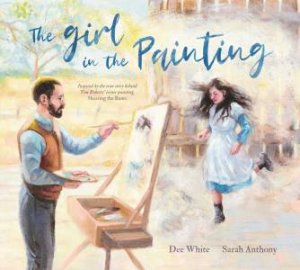The girl in the painting by Dee White and Deirdre White. Illus. by Sarah Anthony

During the late 19th century a strong nationalistic sentiment developed in Australia particularly as the moves towards uniting the six British colonies into one nation grew and the value of the wool industry to the economy was recognised. One of the outcomes was the growth on what became known as the Heidelberg School - a group of artists which included Tom Roberts, Arthur Streeton, Frederick McCubbin, and Charles Conder who chose to capture iconic Australian outdoor scenes that focused on the unique light and colours of the landscape and the lives lived within them.
One of the most prominent paintings to emerge was Shearing the Rams created by Tom Roberts during a visit to Brocklesby Station, Corowa, New South Wales, in the late spring of 1888 and which was eventually completed after subsequent visits in 1890.
Shearing the Rams - National Gallery Of Victoria
But this wasn't just a painting of a group of men shearing sheep in a scene that could be found in any shearing shed across the country at the time - it had a unique element embedded in it. For the only person with their face completely visible is in fact, a girl, distinctive because, at the time, girls and women were not found in such sheds. The cry of "ducks on the pond" was (and remains) an indication that a female is approaching and language and behaviour needs to be appropriate. In this intriguing and enlightening story both author and artist in a perfect marriage of text and illustration, explore how this young girl came to be such an unexpected inclusion.
It is the true story of Susie Bourne, shy and all but invisible on the family farm, overshadowed by her rowdy brothers and sister, despite undertaking many of the chores that children were expected to do at the time. Like Roberts, White and Anthony have brought her to life telling a story not just of Susie (who went on to live to almost 99) but one that could lead to a comparison between the lives of children, particularly girls, in the 1890s and those in the 2020s, perhaps even sparking an investigation into not only how they have changed but why, and who was responsible.
Through narrative non fiction like this, the hidden stories of history are uncovered and shared with a new, modern audience, breathing life into little-known, sometimes long-forgotten back stories that are not only fascinating in themselves but offer insights that spark interest and inspiration decades, if not centuries, on. Who knew that a little girl who was paid sixpence by the artist to kick up dust so he could capture just the right light and atmosphere, could lead this reviewer down so many rabbit-holes?
Themes: Tom Roberts, Country life, Artists.
Barbara Braxton